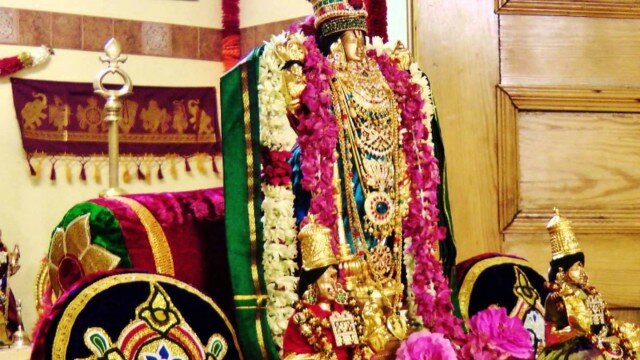Sri Satyanarayanaswamy (Maha Vishnu) Prakara Seva at my Home Thirumaligai (Sanctum) during Nithayanusandhanam (after Thirumanjanam) on Panchaparva Ekadesi.
The images and clips used in this Video are of my Home Deities during Prayer Observance (Sanctum). The audio/sound recordings are used where ever necessary without any commercial intentions or monetary benefit according to “Fair Use” and mainly for educating audience into Vaishnavism, Dravida Vedam (Divyaprabandham), Works of Acharyas, Sanskrit Vedic Hymns, Shlokas, Mantras, Carnatic and Devotional music by providing visuals for better appreciation and for listening pleasure & spiritual realization. Most of the Shlokas, Mantras, Vedas and Divyaprabandhams are available in Public Domain and is recited in all Vaishnava Temples & 108 Divyadesams.
The Thirumaligai hosts Sriman Narayana with his Consorts Sridevi-Bhudevi, Sri Mahalakshmi , Sri Yoga Narasimha, Sri Lakshmi Narasimha, Sri Dolai Kannan (Bala Krishna), Sri Aandal, Sri Ram Parivar, Sri Ramanuja , Sri Manavalamamuni & Sri Satyanarayanaswamy. All Alangarams, Daily rituals (Thenkalai Nithyanusandhanam Sampradaya) and Kainkariyams are performed for the Lord including all auspicious events. Panchaparva Seva & Thirumanjanam (Holy Bath) is performed on Ekadesi, Amavasya, Purnima and when Revathi Star is in Ascendence.
Padma Purana (Devanagari: पद्म पुराण), one of the major eighteen Puranas, a Hindu religious text, is divided into five parts. In the first part of the text, sage Pulastya explains to Bhishma about religion and the essence of the religion. The second part describes in detail Prithvi (earth). In the third part, a description of the cosmos is given, including creation, and description of India (Bharata Varsha). The fourth part describes the life and deeds of Rama. The fifth part is in the style of a dialogue between Shiva and his consort, Parvati, and deals with the essential knowledge about religion.
The Padma Purana is one of the Mahapuranas, dating to roughly between the 8th and the 11th centuries. The Uttara Khanda presents the metaphysical aspects of religion in the form of a dialogue between Shiva and Parvati. This part also contains another version of Vishnu Sahasranama (not the Mahabharata version) and Rama Sahasranama.
Vishnu (Sanskrit विष्णु Viṣṇu) is the supreme God in the Vaishnavite tradition of Hinduism. The Vishnu Sahasranama declares Vishnu as Paramatman (supreme soul) and Parameshwara (supreme God). It describes Vishnu as the All-Pervading essence of all beings, the master of—and beyond—the past, present and future, one who supports, sustains and governs the Universe and originates and develops all elements within. Vishnu governs the aspect of preservation and sustenance of the universe, so he is called “Preserver of the universe”.
In almost all Hindu denominations, Vishnu is either worshipped directly or in the form of his ten Avatara, most famous of whom are Rama, Narasimha and Krishna.
Narayana (Sanskrit: नारायण; nārāyaṇa; Kannada: ನಾರಾಯಣ; Telugu: నారాయణుడు; Tamil: நாராயணன்) or Narayan or Naraina is an important Sanskrit name for Vishnu, and in many contemporary vernaculars a common Indian name. Narayana is also identified as the original man, Purusha. The Puranas present divergent views on Narayana. In the Kurma Purana he is identified with Brahman and Krishna-Vishnu. Narayana is another name for Vishnu and appears as the 245th name in the Vishnu Sahasranama.
Vishnu is always to be depicted holding the four attributes associated with him, being:
1.A conch shell or Shankha, named “Panchajanya”, held by the upper left hand, which represents Vishnu’s power to create and maintain the universe.
2.The chakra, a sharp-spinning discus-like weapon, named “Sudarshana”, held by the upper right hand, which symbolizes the purified spiritualized mind.
3.A mace or Gada, named “Kaumodaki”, held by the lower left hand, symbolizes Vishnu’s divine power is the source all spiritual, mental and physical strength.
4.A lotus flower or Padma, held by the lower right hand, represents spiritual liberation, Divine perfection, purity and the unfolding of Spiritual consciousness within the individual.









